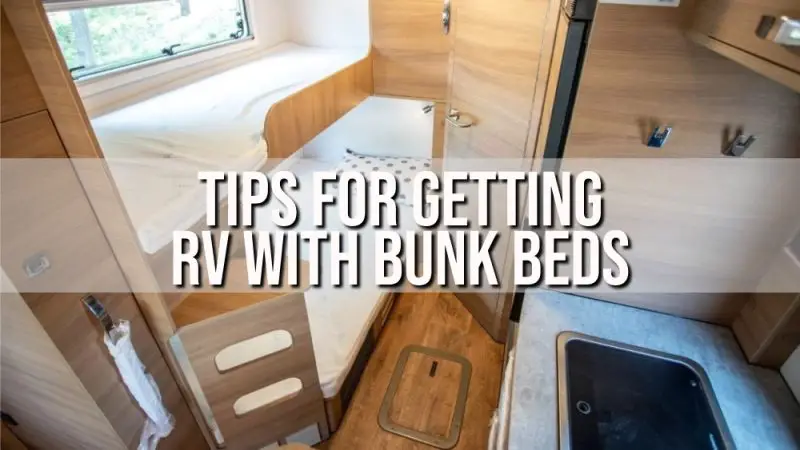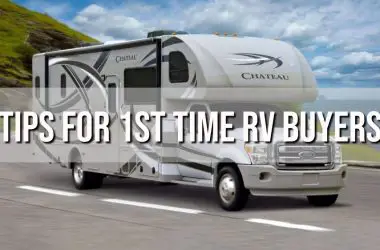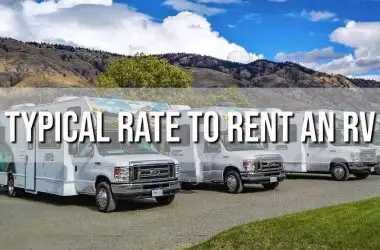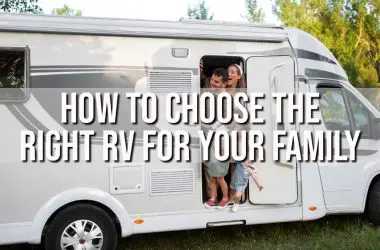Getting RV with bunk beds is a great way to accommodate kids or extra guests while traveling or camping in a recreational vehicle. RVs with bunk beds maximize sleeping space and provide cozy, separate sleeping quarters. Bunks are a popular feature in many types of RVs from Class A to travel trailers. When outfitted with bunk beds, RVs become even more practical and family-friendly.
If you are considering getting an RV with bunk beds, there are several factors to weigh regarding bunk size, layout, safety and more. This guide will cover top tips for choosing the right RV with bunk beds for your needs. We’ll look at bunk bed options in different RV types, ideal bunk counts and configurations, safety considerations and tips for outfitting the bunk space. Use this information to help select your perfect bunk bed camper, trailer or motorhome.
Key Takeaways
- Travel trailers commonly have 1-4 bunks while Class C motorhomes average 2-4 bunks for family-friendly floorplans.
- Optimal bunk size is at least 28″ x 75″ for comfort and storage. Side-by-side and opposing layouts maximize space.
- Prioritize safety with enclosed rails, anchors and protective padding on bunk edges. Consider ladder placement.
- Outfit bunks with bedding, lighting, storage, fans, privacy curtains and entertainment for cozy quarters.
- Compare bunk location, capacity, size, safety features and overall RV layout when choosing an RV with bunk beds.
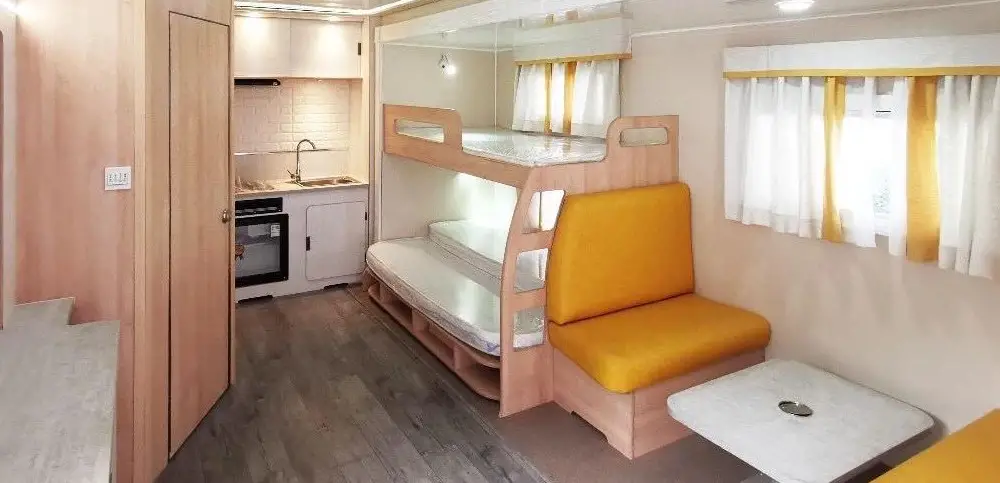
Types of RVs with Bunk Bed Options
If you are looking to get an RV with bunk beds, a wide variety of RV types offer bunk bed configurations. Certain models are particularly well-suited for incorporating bunks into the floorplan. Here is an overview of bunk bed options in different RV classes:
Travel Trailers Travel trailers commonly feature bunk beds, especially in family-friendly layouts. Look for models like Jayco Jay Feather, Forest River Wildwood and Coachmen Clipper Express with 1-4 bunks. The low profile and open floorplans of travel trailers easily accommodate bunks.
Fifth Wheels Though less common, some fifth wheels like the Keystone Cougar and Dutchmen Voltage offer bunkhouse fifth wheel models with up to 4 bunks. The front bedroom rear bunk layout provides separation.
Class C Motorhomes Class C RVs often have 2-4 bunk beds in the cabover or rear, such as Thor Four Winds, Winnebago Minnie Winnie and Coachmen Leprechaun models. Bunks maximize sleeping capacity.
Class A Motorhomes Big Class A motorhomes may have bunk beds or convertible bunks like the Jayco Embark. Bunks beds allow for additional guests while saving main bedroom space.
Class B Camper Vans Compact Class B vans have limited space but some models like Pleasure-Way Tofino offer convertible bunk beds for 2 extra sleep spaces.
Toy Haulers Toy hauler fifth wheels and travel trailers tend to have couches that convert into bunk beds such as Keystone Outback and Heartland Cyclone.
Ideal Bunk Bed Counts and Layouts
When choosing an RV with bunk beds, look for a layout and bunk count that fits your needs. Here are some top bunk bed configuration options:
Two Bunks Many RVs have two bunk beds which sleeps 2-4 kids or adults. A 28″ x 75” bunk size leaves room for seating below. Side-by-side or L-shaped layouts work well.
Four Bunks Some larger travel trailers and motorhomes have four bunks for extra sleeping capacity. Two on each side of the RV or L-shaped provide separation. Great for large families.
Front Cabover Bunks Class C motorhomes often have two bunks in the front cabover for kids to sleep separate from the rear bedroom.
Rear Corner Bunks Rear corner placement uses space efficiently. Allows for private master bedroom upfront.
Sidewall Bunk Beds Bunks along the RV sidewalls maximize interior floorspace since they don’t encroach on the living space.
Convertible Sofa Models like the Winnebago Minnie Winnie have U-shaped dinettes or sofa sleepers that convert into bunk beds as needed. Creates a multi-use space.
Take into account your passenger count, sleeping layout needs and desired separation of quarters to choose the ideal bunk count and placement when getting an RV.

Key Bunk Bed Size and Design Factors
Beyond just bunk count and location, also evaluate bunk sizing, design and spacing:
Minimum Bunk Dimensions Look for bunks at least 28-30” wide x 75-80” long for adult comfort. Narrow 24” wide bunks work for kids. Optimal standard RV bunk size is 30” x 76”.
Upper vs Lower Bunks Consider who will use each bunk. Lower bunks are easiest access. Upper bunks feel more private and may have entertainment.
Matching Mattress Sizes It’s convenient when upper and lower bunks take the same mattress size. Makes swapping or replacing bunk mattresses easier.
**Padded Bunk Ends ** Exposed bunk ends pose a hazard. Seek models with protective padded bunk end covers to prevent injury.
Comfort Features Added comforts like mattresses, storage, lighting, charging ports, fans and entertainment prep make bunk quarters more enjoyable.
Space Below Bunk Look for open space under the lower bunks for storage or seating with a dinette table. Leave room to move about.
Prioritizing Bunk Safety in RVs
One of the most important considerations when purchasing an RV with bunk beds is safety. Look for the following bunk bed safety features:
- Enclosed Railings – The upper bunk should have a railing on both sides to prevent falls. Railings that fully enclose the bunk offer maximum protection.
- Anchors – Bunk beds should be securely anchored to the RV walls/floor. This prevents shifting that could lead to collapse.
- Low Clearance – Upper bunks shouldn’t exceed mattress height by more than a foot to avoid head impacts.
- Padding – Exposed corners and edges of the bunk should be cushioned to prevent injury.
- Ladder – A fixed bunk ladder allows easy, safe access to upper bunks. Check ladder placement and construction.
- Size – Bunks should be long enough for occupants to lay flat without limbs hanging over edges.
- Ventilation – Adequate airflow prevents stuffiness. Look for windows near bunks or install fans.
- Lighting – Reading lights allow for visibility entering and exiting bunks at night.
Choose an RV manufacturer that follows strict bunk safety guidelines and test standards. Your family’s safety should be the top priority.
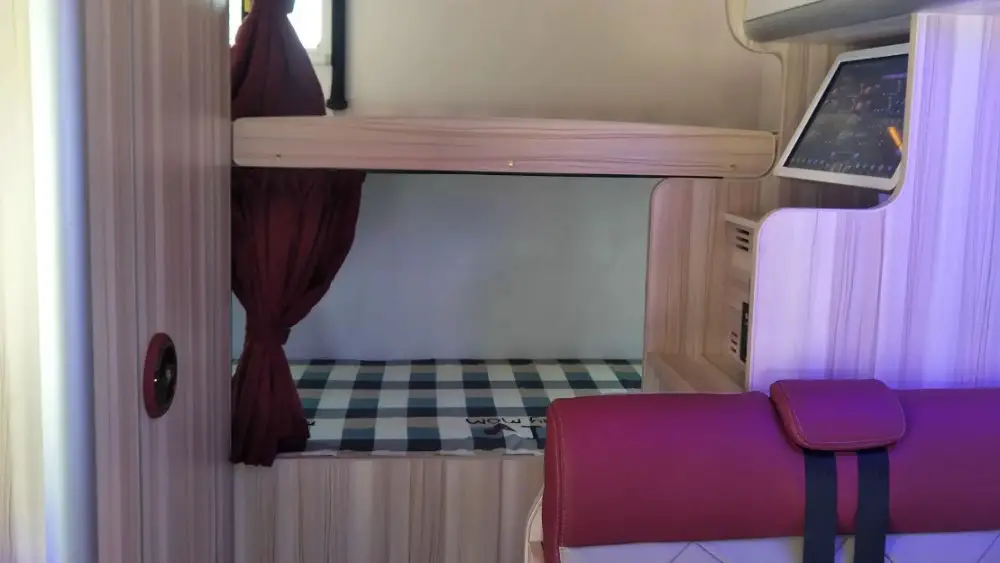
Outfitting Your RV Bunk Quarters
After selecting the ideal RV for your family’s needs that includes inviting bunk beds for the kids or extra guests, it’s time to start outfitting the bunk space to make it as comfortable, convenient and homey as possible. Putting some thought and effort into decorating and appointing the bunk quarters will ensure everyone enjoys this cozy separate sleeping area that encourages peaceful rest and relaxation on the road.
One of the first steps is to install soft, high-quality bedspreads, blankets, sheets, and pillows on each bunk bed so they are ready for a great night’s sleep. Choose bedding materials that seem warm and welcoming like flannel sheets in the winter or lightweight cotton in warmer months. Make sure to select bedspreads and pillow covers that are machine washable for easy cleaning, especially if younger kids will be using the bunks. You want bedding that looks nice but can withstand some heavy use. For families with multiple kids using the bunks, it can be fun to allow each child to pick out their own bunk bedding in their favorite colors and patterns.
Another useful addition is to install bunk fans in the ceiling or upper walls to provide soothing airflow and improved temperature regulation in the confined sleeping quarters. Upper bunks in particular can become quite stuffy and warm due to minimal air circulation, so providing each bunk with its own reading light and fan allows users to customize their own comfort level. Kidde and RecPro are popular brands of RV bunk fans to consider. Strategically place them to avoid direct blowing on sleepers.
For safety and convenience during nighttime trips to the bathroom, keep a supply of portable, battery-powered nightlights on hand to temporarily illuminate the path from the bunks to the RV’s bathroom. This prevents tripping over shoes or belongings left on the floor. Glow-in-the-dark handles on the bunk privacy curtains also help locate the exit. For younger kids, install a bright motion-sensing light that automatically turns on when they start moving down from their bunk.
If the bunk beds area is immediately adjacent to common living spaces in the RV, installing sliding privacy curtains for each bunk creates a more separated sleeping environment and helps minimize nighttime disturbances from others moving around. Darkening curtains also allow for sleeping in later when family members wake up at different times. Curtains can attach directly to the edge of the upper bunks or on small tracks along the ceiling or walls.
To create a special space kids will love, use decorative wall decals, linens, pillows and organizers to customize the bunk quarters to your family’s interests. Nature scenes, starscapes or vehicle decals can make boring blank walls more fun. Storage hammocks, bins and cubbies for each child maximize organization of toys, books, flashlights or electronic devices. Make sure everything is securely contained while traveling.
For entertainment during down time, mount flat screen TVs on swivel arms at the end of the bunk beds so kids can comfortably watch movies and play games from their beds. Include headphone jacks as well so multiple kids can privately listen without noise distractions. Some RVs come prep-wired for adding bunk TVs and devices. If not, consult an RV technician about properly installing the electrical setup. TV placement should not obstruct bunk access or emergency exit routes.
As a safety reminder, verify that all upper bunk beds have proper railings and guardrails around the exterior to prevent falls and allow open visibility. Any hazardous openings should be addressed prior to use. Also consider installing protective padding on sharp upper bunk corners or install bumpers on the ceiling to prevent head injuries.
If additional privacy is desired between separate bunk pairs, installing rolling doors or partitions between the bunks provides that extra bit of visual and audible separation. This is especially useful in larger family groups when bunks are located in a common area. Kids have different bedtimes and separation helps them truly unwind.
Finally, use coordinating sheets, pillowcases and bedspreads to distinguish each bunk if needed. This allows kids or guests to easily identify their assigned sleeping space. It also adds a cohesive decorative touch to bunks located together in larger RV models. Match the bunk decor to the personalities of whomever will be using that space for the ultimate personalized touch.
By incorporating smart storage solutions, lighting, linens, fans and entertainment into your RV’s bunkhouse, the space quickly transforms into a favorite area full of possibilities your whole family will enjoy. The bunk quarters become a comfortable retreat for kids and adults alike.
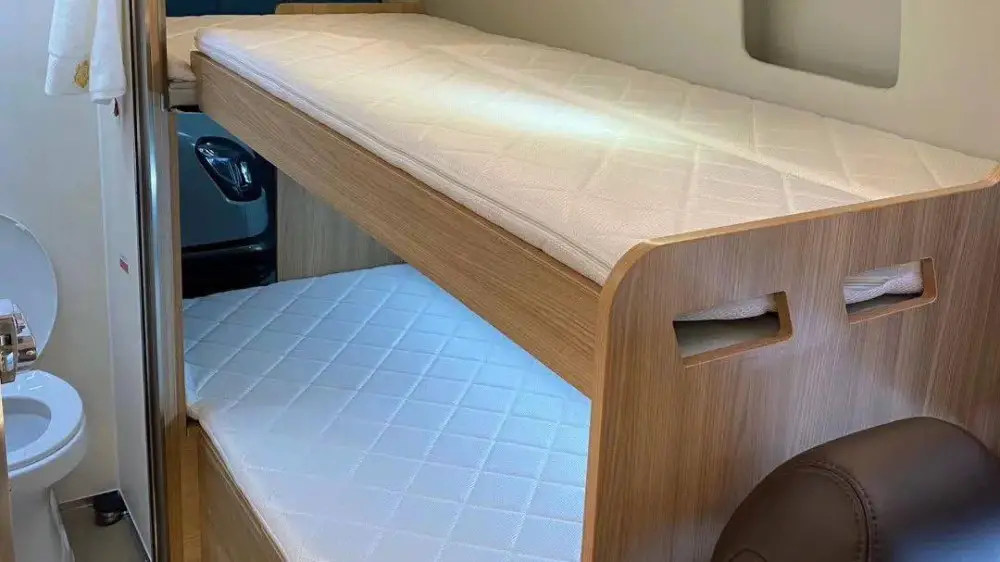
Key Factors When Selecting an RV with Bunk Beds
When searching for a recreational vehicle with bunk beds that will meet your family’s needs, there are several key factors to keep in mind as you evaluate different models. Carefully considering bunk bed specifics along with overall RV construction and layout will help guide you to the perfect camper, trailer, or motorhome with a bunkhouse layout your family will love.
One of the first aspects to think about is the number and layout of bunk beds needed to comfortably accommodate your family or travel crew. A small trailer with just one set of bunk beds may be sufficient for parents with 1-2 young kids but a large family will require several bunks, ideally with a dedicated kids’ room or bunkhouse area. Prioritize models with the ideal bunk count for your passengers and look at how the bunks are positioned within the RV interior design.
When looking at bunk dimensions, ensure the beds will be roomy enough for a comfortable night’s sleep. Standard RV bunk sizes range from 24-30 inches wide and 75-80 inches long. Measure the bunk lengths in any RV you are considering to make sure tall teens or adults will fit without their feet hanging off the edge. Also check that upper bunks have enough unobstructed ceiling clearance when sitting up. You want plenty of wiggle room.
Factor in the overall RV type and floorplan that will work best for regularly accommodating extra bunk bed sleepers. Travel trailers tend to have space designs amenable to bunks but you can also find suitable bunkhouse configurations in Class C motorhomes. The number of slides and separation from master bedroom should align with your needs.
One of the top priorities is evaluating the bunk bed safety features. Look for fully enclosed railings around upper bunks to prevent falls, especially for younger occupants. Make sure the bunks are securely anchored to the RV walls and floor to avoid collapse or shifting during transit. Exposed corners and edges should have protective padding added to minimize injury risk.
Pay attention to standard mattress sizes used in the RV bunks and whether they match your own mattresses or bedding. You’ll want to measure carefully to ensure correct sizing or plan to purchase RV-specific bunk mattresses. Some beds utilize shortened mattresses for the confined space, so double check dimensions.
To determine if the bunk location seems appropriate, look at how the bunks fit into the overall RV floorplan flow. Bunks at the rear, in the cabover area or along the sides typically work best. Ensure there is an easy exit route from the bunks and convenient access to a bathroom.
Check that there is adequate storage space built into the bunk bed area to accommodate belongings. Built-in shelving, cabinets, Cupboards and storage nooks are key when fitting a family group into a confined area. Every inch of storage helps maximize space.
Handy amenities that improve bunk comfort include individual lighting at each bed, charging stations or USB ports for devices, and wall-mounted fans for fresher air circulation in the enclosed sleeping area. If existing, these extras make bunk time more enjoyable.
Pay attention to any windows or skylights located near the bunks which allow beneficial natural light and air flow. Coverings should be provided for darkness when sleeping. Proper ventilation prevents stale air.
The upper bunks should have a fixed ladder or steps in a convenient spot for safe and easy access. Wall cutouts and handles also aid climbing in and out of the top bunk. Make sure the ladder placement doesn’t impede floorspace.
Check the manufacturer’s weight limits for the bunk beds and confirming the intended capacities align with your needs. The structural integrity must be suitable for supporting average bunk occupants. Weight limits are commonly 300-500 lbs per bunk.
Finally, evaluate bunk comfort, privacy and separation based on your family’s preferences. From curtain dividers to entertainment screens, look for features that will enhance the bunk experience on the road. Focus on the details that matter most for a great fit.
Top Brands and Models with Bunk Beds
Not sure where to start your RV search? Here are some top manufacturers and bunk bed models to consider:
Jayco Jay Flight/Jay Feather
- Travel trailers with 1-4 bunk floorplans
- Bunks often in rear with entertainment systems
- Bunk room doors and large windows
Coachmen Clipper Express/Sportscoach
- Travel trailer, class C and class A models with bunks
- Corner bed layout maximizes interior space
- Access ladder and bunk padding
Keystone Cougar
- 1-4 bunks in bunkhouse fifth wheel models
- Convertible sofa into bunk beds
- Padded bunk walls and privacy curtains
Winnebago Minnie Winnie
- Class C with cabover or rear bunk beds
- U-shaped dinette converts to bunk beds
- Sleeps up to 10 with bunk options
Dutchmen Voltage
- Fifth wheel with up to 4 bunk beds
- Double over double opposing bunks
- Comfortable mattress sizes
Thor Four Winds
- Class C bunk models with up to 4 beds
- Removable fixed bunk ladders for access
- Bedside bunk USB charging
This covers some top RV choices to consider that offer quality, family-friendly bunk bed configurations.
Conclusion for Getting RV with Bunk Beds
Getting an RV with bunk beds opens up great family-friendly travel possibilities. Evaluate your needs in terms of bunk count, design, safety and comfort features. Measure bunk dimensions and look at the overall RV floorplan flow. Finding the ideal recreational vehicle with the right bunk beds for your crew allows you to cruise in comfort. Carefully selected bunks create the ultimate accommodations for Roadtrippers both big and small!
Frequently Asked Questions About RVs with Bunk Beds
Questions commonly come up when searching for an RV with bunk beds. Here are answers to some key questions:
What is the best RV for bunk beds?
Travel trailers and Class C motorhomes often have ideal bunk bed layouts. Look at family-friendly models by Jayco, Coachmen, and Winnebago.
What is the optimal RV bunk bed size?
Standard RV bunk dimensions are 28-30” wide x 75-80” long. At minimum, bunks should be 24” x 72” for a twin mattress to fit.
How many bunk beds fit in an RV?
Most RVs have 2-4 bunk beds. Small travel trailers may have just one bunk, while large trailers and motorhomes can fit up to four bunks for maximum sleeping capacity.
Where are bunk beds usually located in an RV?
Common bunk locations are the rear corner, cabover, along the sidewalls, or in a dedicated bunk room in larger models. Convertible dinettes also create bunk beds.
Are RV bunk beds safe for use during travel?
Many bunks have anchors and seatbelts to secure passengers safely during transit. However, it’s best to only have bunks occupied when parked. Consult the manufacturer.
What is the weight limit for RV bunk beds?
Bunk weight limits average 300-500 lbs. Upper bunks may have lower limits than lower bunks. Always refer to the manufacturer’s specifications.
Can you replace RV bunk mattresses?
Yes, standard RV bunk sizes make it easy to replace mattresses. Just be sure to get the precisely matching dimensions for a proper fit.
How much storage is near bunk beds in RVs?
Look for models with cabinets, shelves, and storage nooks and crannies conveniently located in the bunk area for belongings.
Should I get an RV with 2, 3 or 4 bunks?
Choose the bunk count based on your travel party size. Two bunks sleep up to four. Three to four bunks work best for larger families.
What amenities help make bunk beds more comfortable?
Added comfort features include privacy curtains, reading lights, overhead fans, outlets or USB charging ports, and wall padding.


